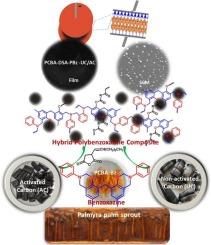高k电介质用对甲酚-双酚基杂化聚苯并恶嗪复合材料:巴尔米拉芽碳活化的作用
IF 6.3
2区 化学
Q1 POLYMER SCIENCE
引用次数: 0
摘要
以甲醛和苯胺为原料,对甲酚基双酚(PCB)为原料,经曼尼希缩合反应合成了新型苯并恶嗪树脂(PCBA-Bz),并进行了单独聚合(PCBA-PBz)和与十二烷基丁二酸酐(DSA) (PCBA-DSA-PBz)的热共聚。同时,通过三种不同的工艺对Palmyra芽进行炭化和活化,得到了非活性碳(UC)和磷酸(ACH3PO4)、氢氧化钾(ACKOH)和氢氧化钠(ACNaOH)的活性碳(AC),并通过BET表面积分析、拉曼光谱和FTIR光谱对其进行了研究,并将其作为补强剂。BET研究表明,活性炭的比表面积高于未活化的活性炭。研究了碳增强剂对聚苯并恶嗪复合材料(PCBA-PBz- uc /AC1-9)介电性能和热性能的影响,并与纯PCBA-PBz和杂化PCBA-DSA-PBz基体进行了比较。对复合材料的表面形貌和拒水性进行了测试,发现杂化的PCBA-DSA-PBz及其复合材料具有超疏水性,其水接触角大于150°。ACNaOH增强聚苯并恶嗪复合材料(PBz-ACNaOH9)在1 MHz处介电常数最高,为17.16,正切损耗值为0.711。本文章由计算机程序翻译,如有差异,请以英文原文为准。

A new p-cresol-bisphenol based hybrid polybenzoxazine composites for high-k dielectrics: The role of Palmyra sprout carbon activation
A new benzoxazine resin (PCBA-Bz) was synthesized from p-cresol-based bisphenol (PCB) using formaldehyde and aniline through Mannich condensation and it was polymerized (PCBA-PBz) alone, as well as copolymerized separately with dodecenylsuccinic anhydride (DSA) (PCBA-DSA-PBz) under thermal treatment. Concurrently, the Palmyra sprout was carbonized as such and activated by three different process, results in a non-activated bio-carbon (UC) and activated bio-carbons (AC) using phosphoric acid (ACH3PO4), potassium hydroxide (ACKOH), and sodium hydroxide (ACNaOH), which were studied by BET surface area analysis, Raman and FTIR spectra, and were used as a reinforcement. BET studies indicate that the specific surface area of the activated carbons was higher than that of non-activated one. Influence of the prepared carbon reinforcements in the dielectric behaviour and thermal properties of the polybenzoxazine composites (PCBA-PBz-UC/AC1-9) were studied and compared to those of neat PCBA-PBz and hybrid PCBA-DSA-PBz matrices. The surface morphology and water repellency of the composites were also examined, the hybrid PCBA-DSA-PBz and its composites display a super hydrophobic behaviour having the values of water contact angle at above 150°. The ACNaOH reinforced polybenzoxazine composites (PBz-ACNaOH9) exhibits the highest value of dielectric constant of 17.16 with tangent loss value of 0.711 at 1 MHz.
求助全文
通过发布文献求助,成功后即可免费获取论文全文。
去求助
来源期刊

European Polymer Journal
化学-高分子科学
CiteScore
9.90
自引率
10.00%
发文量
691
审稿时长
23 days
期刊介绍:
European Polymer Journal is dedicated to publishing work on fundamental and applied polymer chemistry and macromolecular materials. The journal covers all aspects of polymer synthesis, including polymerization mechanisms and chemical functional transformations, with a focus on novel polymers and the relationships between molecular structure and polymer properties. In addition, we welcome submissions on bio-based or renewable polymers, stimuli-responsive systems and polymer bio-hybrids. European Polymer Journal also publishes research on the biomedical application of polymers, including drug delivery and regenerative medicine. The main scope is covered but not limited to the following core research areas:
Polymer synthesis and functionalization
• Novel synthetic routes for polymerization, functional modification, controlled/living polymerization and precision polymers.
Stimuli-responsive polymers
• Including shape memory and self-healing polymers.
Supramolecular polymers and self-assembly
• Molecular recognition and higher order polymer structures.
Renewable and sustainable polymers
• Bio-based, biodegradable and anti-microbial polymers and polymeric bio-nanocomposites.
Polymers at interfaces and surfaces
• Chemistry and engineering of surfaces with biological relevance, including patterning, antifouling polymers and polymers for membrane applications.
Biomedical applications and nanomedicine
• Polymers for regenerative medicine, drug delivery molecular release and gene therapy
The scope of European Polymer Journal no longer includes Polymer Physics.
 求助内容:
求助内容: 应助结果提醒方式:
应助结果提醒方式:


